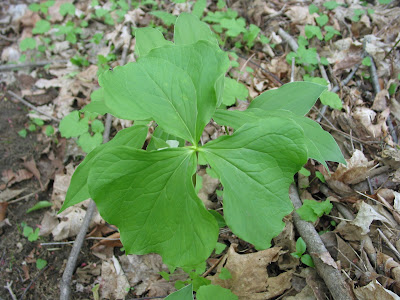Since February I have been writing a bi-weekly column --
The Spicebush Journal -- for the
White Mountain Shopper, a free local newspaper serving central and northern New Hampshire. My blog friend John Compton suggested that I take over his space with my own column as he ended many years of writing his
Walking the Whites. You can follow his hiking adventures at
http://1happyhiker.blogspot.com.
In my most recent column for the White Mountain Shopper I recounted my recent adventures scrambling around rock outcrops. Here is what I wrote:
During my regular wanderings in woods and wetlands in search of wildlife
and to assess their habitats, I bushwhack up slopes, step over fallen trees,
and slog through dense underbrush. I listen for bird songs, search muddy trails
for mammal tracks, peer into trees with hawk nests, and turn over logs and
rocks to find salamanders. In New Hampshire, most every property that I visit
has rocky areas to explore. Some are small enough to walk around, others
require some scrambling up steep slopes and hiking among large rock outcrops.
I look for crevices in the rocks, places where a porcupine might live.
Most people recognize porcupines for their quills – 30,000 in all on their
head, back, and tail. Quill encounters are often the result of a curious dog
getting too close to a porcupine. The quills are released only on contact,
usually around and in a dog’s mouth. With such a great defense against
predators, porcupines can afford to be slow. Regrettably this results in many
getting killed by vehicles as they waddle with a hunched back slowly across a
road at night.
A porcupine shows his large, orange incisors, body of quills, and hunched back
Among rock outcrops and other potential porcupine den sites such as a
hollow tree, there are several telltale signs that a porcupine is near.
Porcupines are vegetarians, eating needles, twigs, and bark of evergreens in
winter, especially hemlock. If the forest floor beneath a hemlock is littered
with small hemlock branches than you’ve got a porcupine nearby, perhaps napping
up in that very tree. They have four bright orange incisors that are meant for
gnawing. This combined with their craving for salt leads them to chew on salty
things – axe handles, work gloves, leather boots, shed deer or moose antlers,
as well as salt in roadsides. In summer, porcupines eat a more varied diet of
fruits, seeds, nuts, leaves, grasses, and flowers.
I recently surveyed a property with expansive rock outcrops that were
far from roads and other disturbance. Every crevice in the rock outcrop had
been used by a porcupine in the past or was an active den site. I could tell
because porcupines use the entrance to their den as a latrine. Openings to
porcupine den sites can accumulate quite a large pile of droppings or scat.
This makes it easy for the parents to train a newborn, called a pup or a
porcupette, since they don’t have to travel far to the outhouse.
The entrance to a porcupine den; note the large pile of droppings
As I scrambled around this particular large rock outcrop, noting all the
porcupine activity, a big black bird flew up and away from one large crevice.
It was a turkey vulture. The bird surprised me, but as I climbed up to get a
closer look I saw two large eggs tucked into a large opening in the rock,
nestled on a bed of soft porcupine scat. This was my first ever find of a
vulture nest site. Turkey vultures do not build a nest and often lay their eggs
in rock outcrops. As I walked away, I watched the pair of vultures soar
overhead, waiting for me to leave their nest site before returning to their
secluded eggs.
A turkey vulture nest in an old porcupine den;
the two eggs are nestled on a bed of porcupine scat
Turkey vultures have expanded their range into the Northeast in recent
years. It is now common to see them soaring, with their wings upturned in a
v-shape or dihedral. Their bald head, which is red in adults, is a useful
adaptation to a life of eating dead things or carrion. A feathered head would
get messy when the vulture sticks its head into a carcass. The turkey vulture
is nearly as big as an eagle, so it was quite a sight to see one fly out of the
rock outcrop that I was exploring.
Another animal that I look for in large expansive rock outcrops is the
bobcat. They too are expanding their range, their population increasing in New
Hampshire. Bobcat prey mostly on small mammals
-- snowshoe hare, squirrels, mice and voles – and sometimes birds. They
prefer to den in rock crevices. I saw no sign of bobcat on this visit, but
winter is a better time to note their presence in rocky places.
At first glance a rock outcrop may seem an unlikely place for wildlife,
but a closer look may reveal much more in any season.








.jpg)
.JPG)
.JPG)
.JPG)


























